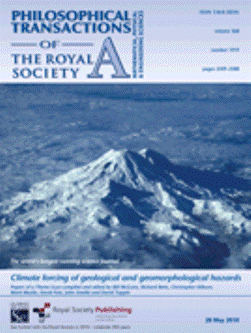Climate Forcing of Geological and Geomorphological Hazards
Themed Issue (Vol.368) of Philosophical Transactions of the Royal Society (A)
W McGuire, R Betts, C Kilburn, M Maslin, D Pyle, J Smellie & D Tappin (eds)
Published by: The Royal Society
Publication date: May, 2010
ISSN: 1471-2962
List price: £47.50
pp 2311-2588
[email protected]

This publication followed the Third Johnston-Lavis Colloquium held at University College London in September 2009. Twelve research papers are included in the collection looking at potential lithospheric responses to climate change. This is an unusual perspective on the issues surrounding climate change, focusing on a plausible set of lithospheric impacts that could arise from anthropomorphic climate change – all assuming that the generally accepted “scientific consensus” of a 2
0C to 4
0C rise in global temperature occurs in the foreseeable future.
The papers can be classified as presenting evidence with respect to general concepts (x2 papers), methane hydrate feedbacks (x2), tsunami triggered by submarine slope failures (x1), mass wasting processes on land and slope instability (x2), seismicity (x2) and volcanism (x3). It would be unfair to label these as “worst case” scenarios – as they start out from what appears to be the current received position. Individually the processes described are entirely plausible, some with fascinating case histories as evidence (Huggel et al on Mt Cook and McGuire describing the Kolka glacier failure are particularly interesting), but for this reviewer the collection lacks credibility as a whole.
Anyone who deals with failure analyses in Earth systems, and in geotechnical and geomorphological processes in particular, will understand how difficult it is to pin down cause and effect in complex systems. Slopes, for example, fail due to a particular combination of events acting at a particular time, and while it is frequently the case that in engineering systems at least it is often relatively easy to isolate a change (e.g. in groundwater conditions, due perhaps to a blocked drain or a particularly intense rainfall event), in natural slope failures such deterministic conclusions are far less easily made.
If it is accepted that the scientific method comprises the formulation of a hypothesis, followed by its rigorous testing under controlled conditions, this collection of papers is only dealing with one part of that method. These are in effect a collection of hypotheses, which effectively appear to be untestable. That, of course, is not the fault of the many authors involved in producing this collection, but it is a fundamental problem with events that occur within geological rather than human time frames. Gaia’s revenge, if and when she sees fit to serve it, will be the coldest of cold dishes, and it is doubtful that anyone likely to read this volume will ever be in a position to confirm these hypotheses by direct observation.
There is plenty of evidence here for those that wish to paint a picture of how bad things could be, and given recent events like the Boxing Day tsunami, the Haitian earthquake and Chinese landslides, one could read this book and start seeing visions of the Horsemen of the Apocalypse. Indeed the description presented in the book of the volcanic risks associated with Iceland seems at times to be almost prescient.
The collection offers interesting base material for those teaching Earth hazards and risks, and will enable students to see beyond standard course materials. The collection as a whole raises far more questions than it answers however. This point is not lost on the authors themselves, and is covered by an interesting discussion on volcanism and climate change. Whether or not the solution to this problem advocated in the conclusion (i.e. more modelling) will ever provide us with more answers than questions is a point on which I remain to be convinced.
Keith Nicholls